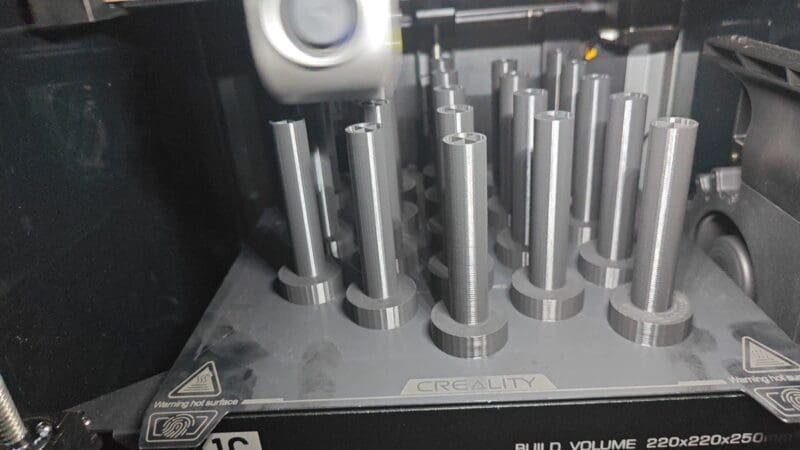Is 3D Printing Filament Toxic? (Short Answer)
Ever wondered if your 3D printing hobby might be secretly harming you with toxic fumes?
Absolutely, it’s a valid concern! But here’s the deal: the toxicity of 3D printing filaments can vary based on the type of material used. Some filaments, like ABS, can release potentially harmful fumes when heated, while others, like PLA, are considered safer because they’re made from cornstarch and emit a much less harmful substance.
Ultra Fine Particles (UFPs) and Volatile Organic Compounds (VOCs)
When it comes to the potential health risks associated with 3D printer filament, two key terms that need to be understood are Ultra Fine Particles (UFPs) and Volatile Organic Compounds (VOCs). These are the primary sources of concern when it comes to the toxicity of 3D printing.
Ultra Fine Particles (UFPs)
UFPs are particles with a diameter of less than 0.1µm, making them easily able to invade the human body and directly impact the lungs. When using FDM 3D printers, UFPs are emitted into the air during the printing process.
The inhalation of these particles can lead to various cardiovascular health risks and increase the chances of developing asthma. Furthermore, UFPs can act as carriers of toxins, entering the bloodstream and potentially causing harm throughout the body.
Volatile Organic Compounds (VOCs)
VOCs are airborne chemicals with a high vapor pressure at room temperature, which means they can easily evaporate into the air. Some commonly known VOCs, such as benzene and methylene chloride, have been linked to cancer.
The Environmental Protection Administration (EPA) classifies VOCs as toxic pollutants. When 3D printing, certain filaments can release VOCs into the air, posing a potential risk to the health of individuals in the vicinity.
Common 3D Printer Filaments: ABS and PLA
It is important to note that not all 3D printer filaments emit the same levels of UFPs and VOCs. ABS (Acrylonitrile Butadiene Styrene) is a filament known to emit higher levels of toxic particles compared to PLA (Polylactic Acid). ABS contains styrene, a hazardous volatile compound that is toxic and potentially cancer-causing.
Read > PETG vs ABS: A Comprehensive Comparison
On the other hand, PLA breaks down into lactic acid, which is a naturally occurring chemical and poses no known health threat.
Read > Top 8 Best High-Speed PLA Filament 2023
ABS is a popular choice for 3D printing due to its strength and durability. However, it is important to note that ABS contains styrene, a hazardous volatile compound that is toxic and potentially cancer-causing.
When ABS is heated during the printing process, it can release fumes that contain styrene particles, which can be harmful if inhaled.
On the other hand, PLA is a biodegradable and environmentally friendly filament that is derived from natural resources such as cornstarch. PLA is generally considered to be safer than ABS because it does not release toxic fumes when melted.
Instead, PLA breaks down into lactic acid, a chemical that is harmless to the body.
While PLA is generally considered to be safer than ABS, it is still important to take precautions when using any type of 3D printer filament. This includes ensuring proper ventilation in the printing area and minimizing exposure to the fumes and particles emitted during the printing process.
In addition to ABS and PLA, there are other filaments available for 3D printing, each with its own set of characteristics and potential health risks. It is important to research and understand the properties of the specific filament you are using to ensure safe printing practices.
How to Improve 3D Printing Safety
While it is important to be aware of the potential dangers, there are steps you can take to improve the safety of your 3D printing process. Here are some tips to help you enhance the safety of your 3D printing experience:
Increase Awareness of the Risks: One of the first steps you can take is to educate yourself and others about the potential health risks associated with 3D printing filaments. This includes informing students, children, and employees who may be using the 3D printer about the potential dangers.
Proper Ventilation: Proper airflow and under pressure are essential for maintaining a safe working environment when using an FDM 3D printer. By directing the particles away from the users and harnessing the airflow, you can minimize the concentration of harmful fumes in the immediate vicinity.
Creating underpressure around the 3D printer can help fume out the emissions from your working environment. If you are printing with ABS, it is highly recommended to use a filtration system to further improve ventilation and reduce the release of toxic particles.
Minimize Exposure: There are additional ways to minimize exposure to potentially harmful emissions.
First, consider using the lower end of the recommended print temperature for the filament you are using. This can help reduce the release of ultrafine particles (UFPs) and volatile organic compounds (VOCs).
Additionally, choosing a filament like PLA, which has lower UFP emissions, can further minimize exposure. Look for authentic and non-toxic PLA filaments that are odorless, biodegradable, and eco-friendly.
By addressing the potential health risks early on and taking proactive steps to improve safety, we can ensure that the benefits of 3D printing are maximized while minimizing any potential harm.
Conclusion
In conclusion, while 3D printing technology offers tremendous benefits, it is important to be mindful of the potential health risks associated with 3D printer filaments. By increasing awareness, improving ventilation, and using safer materials, we can ensure that 3D printing evolves in a way that maximizes its benefits while minimizing any risks involved.
DISCLOSURE: THIS POST MAY CONTAIN AFFILIATE LINKS, MEANING I GET A COMMISSION IF you DECIDE TO MAKE A PURCHASE THROUGH MY LINKS, AT NO COST TO YOU. PLEASE READ MY DISCLOSURE FOR MORE INFO.




